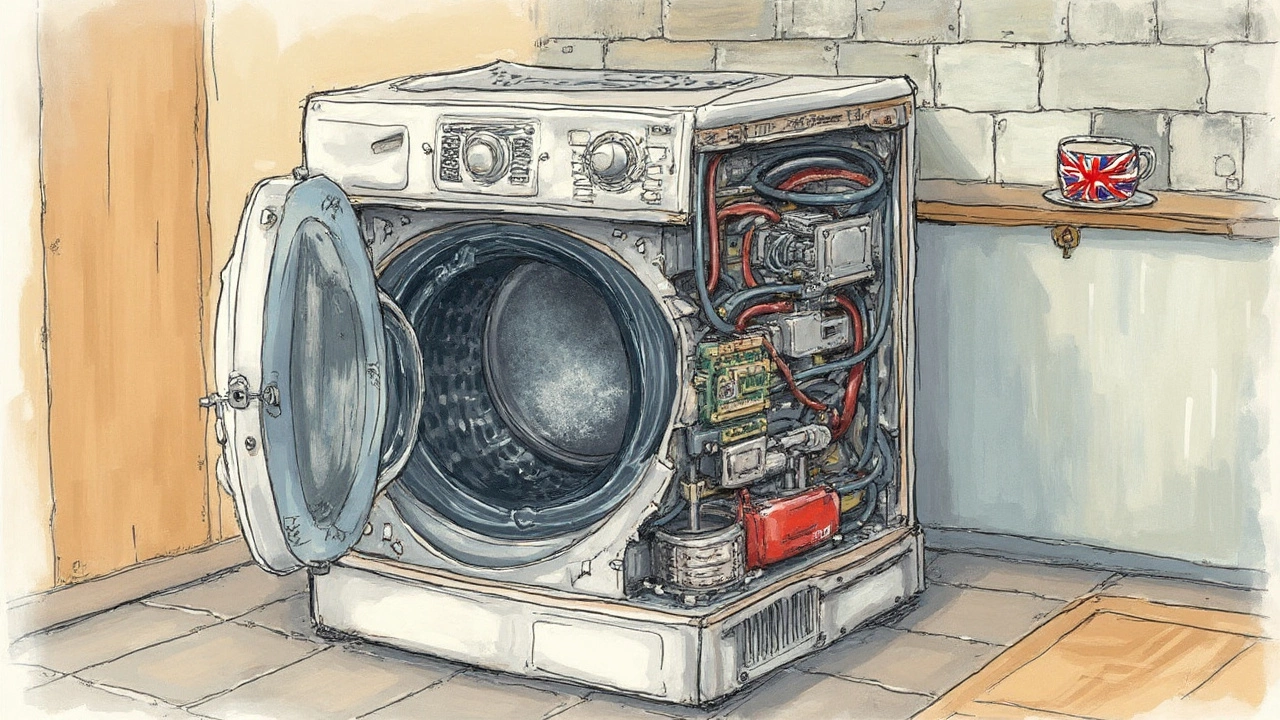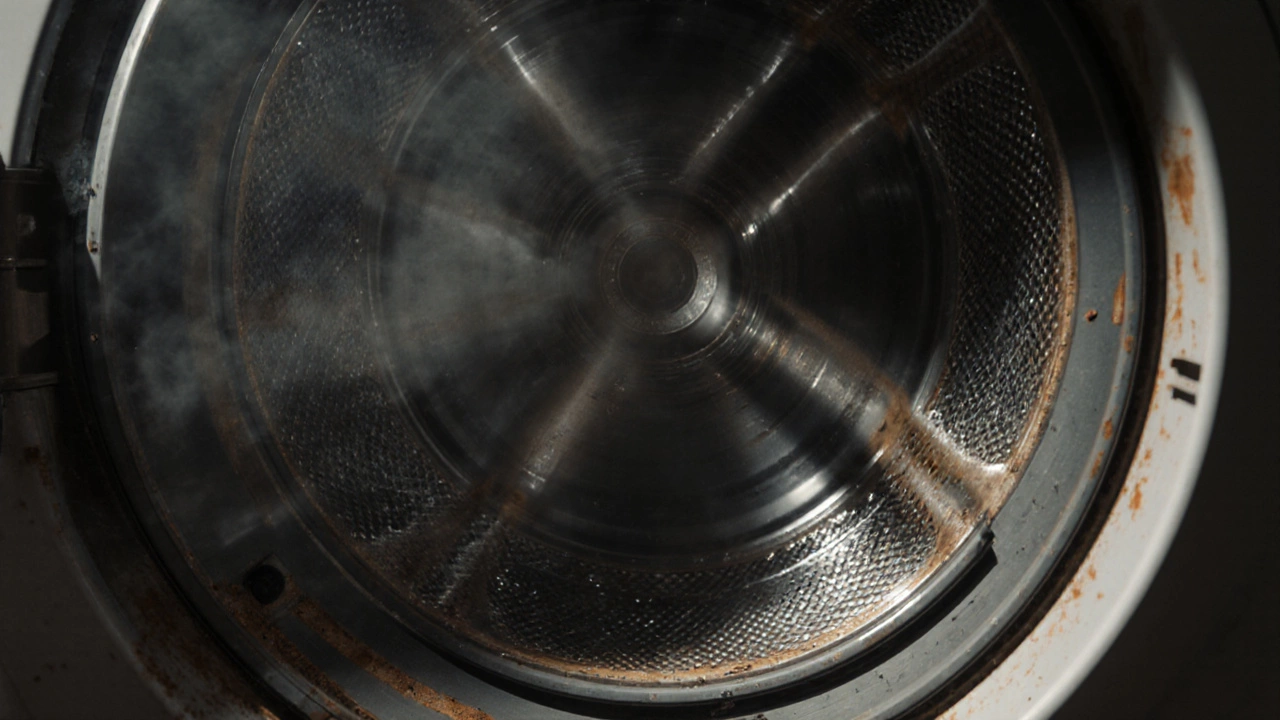
- 3 Aug 2025
- Gideon Thornton
- 0
That moment when your washing machine stops mid-cycle and flashes angry lights feels like sabotage by a household robot. Suddenly, piles of laundry become a growing threat, and you wonder if this is the end of free socks in your drawer. But is it really time to shell out for a pricey repair or new machine? Or could you, with a brisk attitude and a bit of know-how, tackle that broken washer yourself?
What Usually Goes Wrong? Spotting the Problem
Washing machines seem complicated, spinning away with endless cycles and mysterious lights, but the truth is the basics haven’t really changed much for decades. Most faults boil down to a handful of familiar culprits. Maybe the drum won’t spin, or your clothes come out soaked. Sometimes, the thing just doesn’t turn on at all—no power, no protesting beep, nothing. Believe it or not, according to UK repair data from 2023, more than 60% of home washing machine repairs come down to blockages, faulty door locks, worn-out carbon brushes, or dodgy pumps.
If you notice water sitting at the bottom after a cycle, it often means your drain pump is blocked. Hair grips, coins, and crumpled receipts—amazing what gets stuck down there. When the drum spins weakly or not at all, the carbon brushes that power the motor might be spent. No power? Double-check your socket, plug, and fuse before assuming the worst. The classic trick: unplug it, wait a minute, and press every button as you restart—sometimes a simple reset works wonders.
Modern machines can sometimes seem secretive with their coded error messages. If you have the original manual, grab it and look up what those blinking lights or codes mean. If not, a quick online search with your model number should dig up a code list. On many models, two flashes and a pause (repeated) signal a door lock issue.
Bottom line: habitually overloaded machines, using way more detergent than you need, and ignoring the filter can accelerate common failures. Most issues aren’t mysterious. They’re about blocked filters, failed pumps, or electrical bits that get tired after years of service.
Tools and Parts: What You Really Need
Before you go full DIY, peek behind the scenes to see what sort of kit will help you win. You’ll want a set of screwdrivers—Philips and flat-head—since nearly all washing machine panels are secured this way. Pliers, a socket wrench, and a sturdy torch are must-haves. If your tubes look crusty, an old toothbrush is perfect for scrubbing out stubborn build-up. Most repairs also need a towel and a shallow tray, since water always lurks somewhere inside. And don’t forget electrical tape. Even if you’re just peeking inside, safety comes first—unplug the machine and flip off the water supply before tampering.
Many replacement parts for top UK brands like Hotpoint, Bosch, or Beko are surprisingly affordable. You can order new door seals, carbon brushes, or hoses online—just make sure to check your exact model number (usually stuck inside the door or behind the soap tray). Used parts from reliable recyclers are fair game too. According to a Which? survey last year, over 70% of DIYers found the exact bits they needed on eBay or a local Facebook group at a fraction of the price charged by official service centres.
Want to build your own washing machine survival kit? Here’s a quick list:
- Set of screwdrivers (including a stubby and a long one for hard-to-reach places)
- Pliers (needle-nose work best for hose clips)
- Adjustable wrench or socket set
- A low tray or baking dish for water spills
- Flashlight or head torch (hands-free helps)
- Old towels and rags
- Electrical tape
- Replacement filter (handy if yours is clogged solid)
One last tip: keep your model number handy when searching for help or parts. Every screw and panel can be different, even among washers from the same brand.

Common DIY Fixes That Actually Work
So you’ve unplugged everything and cracked open the washing machine. The good news: loads of common repairs are realistically within reach for someone with basic DIY skills. Just go slow and stay organized (snap a photo before removing bits so you’ll remember how to reassemble). Here are three failures you can often fix yourself:
- Washing machine not draining? Nearly all models have a filter or pump trap behind a small door on the front panel. Pop it open, brace for a puddle, and twist out the filter. Rinse any built-up grime, remove tangled threads, and scan for stray socks or coins.
- Door won’t open or lock? First, unplug and try the emergency release (some brands have a pull-cord inside the pump filter hatch). If the machine keeps refusing, the door catch or electronic lock may need replacing—parts and video guides are easily found online. A new lock assembly takes under 30 minutes to fit and costs less than a takeaway for two.
- Spin cycle not working? If the drum turns slowly or not at all, check the drive belt (visible behind the back panel). If it’s slipped off or snapped, swap it out—belt kits and tension tools can be ordered online. Many Hotpoint and Indesit drums also use carbon brushes, which wear down. These are cheap to buy and can be swapped with a screwdriver and a bit of patience.
When doing any of these, always disconnect from the mains power. Sounds simple, but it saves lives. Check pipes and hoses for leaks before switching back on. Put any small screws or clips in a dish so you don’t lose them. If your fix works, reward yourself—you’ve just saved a chunk of cash!
When DIY Just Isn’t Worth It
Some problems cross the line from “handy home repair” into territory best left to professionals. High-voltage electrical faults, leaking tubs or drums, and mysterious smoke or burnt smells should make you pause. If your machine keeps tripping the home circuit breakers (especially with modern RCDs), step back. Live electrics on wet appliances are never worth the risk.
Programming glitches on smart models—touchscreens that ignore you, or codes you just can’t crack—are a headache even for experienced repairers. If your warranty is still valid, don’t void it by popping the case; let the manufacturer handle it. Same goes for models with sealed drums (like some newer Bosch or Samsung washers)—even getting inside these takes special tools the average Bristolian simply doesn’t keep in the shed.
Rule of thumb: if the repair cost is more than half the price of a like-for-like replacement, or your machine is over eight years old and acting cranky, it might be time to start price-hunting. Newer models run quieter, use less water, and save on energy bills—so the maths sometimes balance out, especially with regular deals from British appliance retailers.
That said, don’t bin your old washer too quickly. Bristol has several community repair cafés where volunteers will help you diagnose faults and teach you the ropes. Check local Facebook groups or Repair Café UK to save an otherwise doomed appliance.

Savvy Prevention: Keeping Your Washer Trouble-Free
Let’s face it—doing laundry will never be the most glamorous household chore. But keeping your washing machine happy is shockingly easy when you know a trick or two. For a start, use the right amount of detergent. Most UK homes use double what’s really needed, leaving goo on pipes and sensors that causes blockages. A weekly maintenance wash (60°C, no clothes, a dash of soda crystals or vinegar) zaps grease and limescale. If the drum smells funky, run the hottest cycle empty with a scoop of baking soda and white vinegar. That’ll sort the pong and clean the inside better than pricey cleaners.
Clean your filter monthly—especially if you have pets or enthusiastic toddlers who hide Lego in pockets. Wipe the door rubber seal after every wash, especially in Bristol’s damp climate, to keep mould and black gunk at bay. And never ignore a suspicious knocking, especially during the spin. Fast action can stop a small issue growing into a major headache.
If you live in a hard water area like most of the West Country, descaler tabs or solutions are smart. They protect your machine’s heating element from the relentless Bristol limescale, making things last longer. Try to keep the machine level, wobble-free, and don’t overload with bedding—modern drums can take bulky items, but they’re prone to imbalance if you ram in too much.
Finally, hold on to your manual or download a PDF version; it’s a goldmine of settings, error codes, and step-by-step troubleshooting tips. Modern washers have secret test modes, too—holding certain buttons as you power up can spill machine secrets, letting you diagnose or reset much like the pros. Search forums for your model with "test mode instructions" if you’re curious.
Armed with some confidence, simple tools, and a dose of patience, you can tackle loads of washing machine hiccups yourself. Go slow, look up tutorials, and know when to call in the cavalry. Your socks—and your wallet—will thank you.




